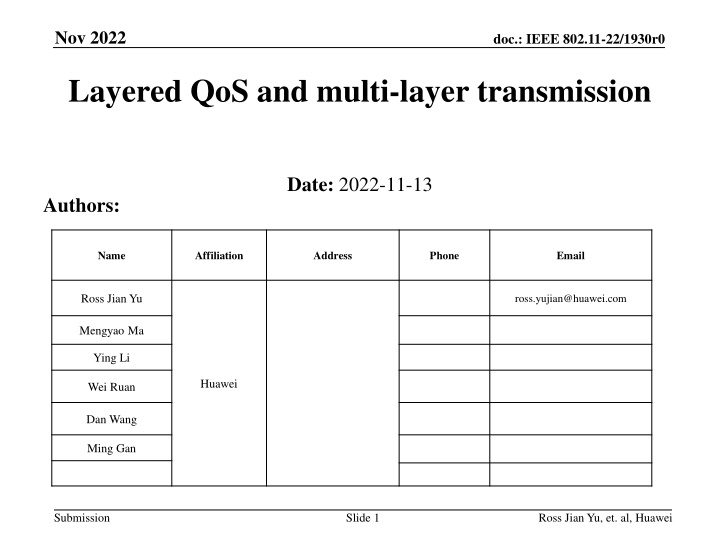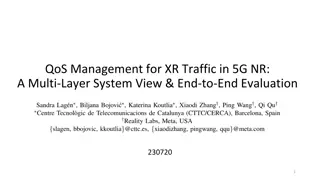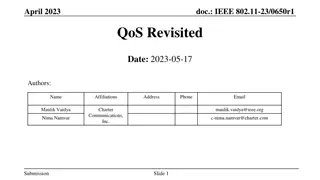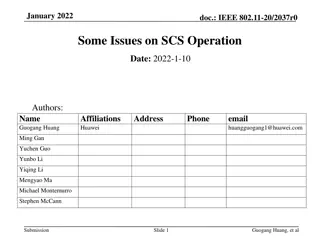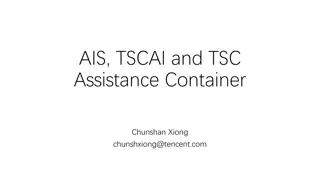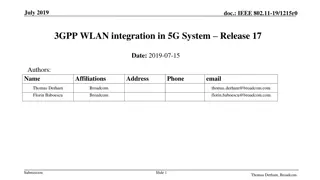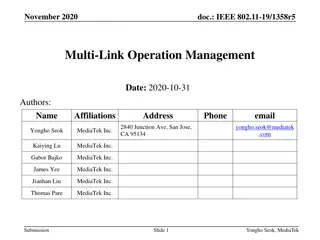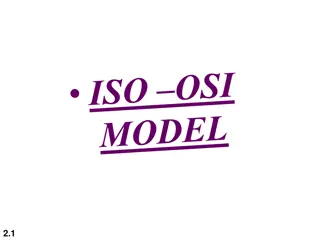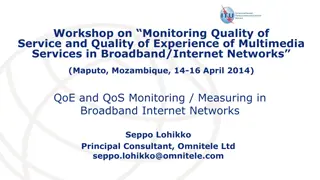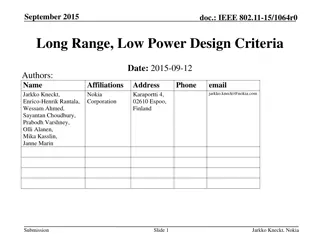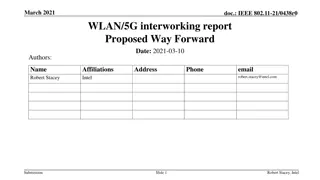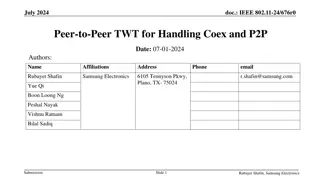Layered QoS and Multi-Layer Transmission in IEEE 802.11-22 for Enhanced WLAN Performance
The document discusses the importance of layered Quality of Service (QoS) and multi-layer transmission in meeting the high throughput and real-time requirements of metaverse applications over WLAN. It emphasizes the need for enhanced throughput, reliability, reduced latency, and improved power efficiency. The focus is on addressing latency reduction through QoS enhancements and unequal error protection. Additionally, it highlights the significance of layered QoS for supporting different modalities of XR services.
Download Presentation

Please find below an Image/Link to download the presentation.
The content on the website is provided AS IS for your information and personal use only. It may not be sold, licensed, or shared on other websites without obtaining consent from the author.If you encounter any issues during the download, it is possible that the publisher has removed the file from their server.
You are allowed to download the files provided on this website for personal or commercial use, subject to the condition that they are used lawfully. All files are the property of their respective owners.
The content on the website is provided AS IS for your information and personal use only. It may not be sold, licensed, or shared on other websites without obtaining consent from the author.
E N D
Presentation Transcript
Nov 2022 doc.: IEEE 802.11-22/1930r0 Layered QoS and multi-layer transmission Date: 2022-11-13 Authors: Name Affiliation Address Phone Email Ross Jian Yu ross.yujian@huawei.com Mengyao Ma Ying Li Huawei Wei Ruan Dan Wang Ming Gan Submission Slide 1 Ross Jian Yu, et. al, Huawei
Nov 2022 doc.: IEEE 802.11-22/1930r0 Recap In [1], it mentions metaverse applications trigger high throughput and stringent real-time delay requirements. Users expect enhanced throughput, enhanced reliability, reduced worst case delay and jitter, and improved power efficiency in supporting their applications over WLAN. In [2], a detailed description on cloud VR use case has been presented, which needs high requirement on Tput and latency. Moreover, two aspects regarding latency reduction has been presented: QoS enhancement Unequal error protection (multi-layer transmission) In this contribution, we will provide more details on those two aspects. Submission Slide 2 Ross Jian Yu, et. al, Huawei
Nov 2022 doc.: IEEE 802.11-22/1930r0 A brief introduction on Video Coding Scalable video coding standard: SVC (Scalable Video Coding) SHVC (Scalable High efficiency Video Coding) Application Video conferencing Video surveillance XR/VR Raw (2560x1440) Source Coding Scalability features Scalable standard Examples Base Layer (1280x720) I B P B I SVC SHVC BL_0 BL_1 BL_4 BL_3 BL_2 Temporal 30fps to 60fps (in HEVC) Spatial 1080p to 4Kx2K SNR(quality) 33dB to 36dB Hybrid codec AVC-coded BL Enhancement Layer (2560x1440) residual_0 residual_1 residual_2 residual_3 residual_4 Bit depth 8 bit to 10 bit Color gamut BT.709 to BT.2020 EL_0 EL_2 EL_3 EL_4 EL_1 I frame (priority A): An I-frame or a Key-Frame or an Intra-fram e consists ONLY of macroblocks that use In tra-prediction. P frame (priority B): : P-frame stands for Predicted Frame and allo ws macroblocks to be compressed using tem poral prediction in addition to spatial predict ion. For motion estimation, P-frames use fra mes that have been previously encoded. B frame (priority B/C): : A B-frame is a frame that can refer to frame s that occur both before and after it. Codec order (bitstream): BL_0 EL_0 BL_2 EL_2 BL_1 EL_1 BL_4 EL_4 BL_3 EL_3 Decoding process of EL: Rec(BL_i +EL_i) = upSampling(Rec(BL_i)) + Rec(EL_i); Error concealment: If (BL_2 is error) Rec(BL_2) = Rec(BL_0); If (EL_2 is error) EL_2 = 0; (drop) Measurement: 2552 ??? PSNR =10log10 Performance Graph : SNR-PSNR RATE-PSNR Submission Slide 3 Ross Jian Yu, et. al, Huawei
Nov 2022 doc.: IEEE 802.11-22/1930r0 Layered QoS For WLAN, layered QoS can be helpful on latency reduction. 802.11aa proposed alternative queues of VI to enable inter-AC prioritization of transport streams (I/P/B frame, or base layer/enhancement layer) [5][6][7]. This can also be helpful for different modalities of XR services (Audio/Video/Haptic Data/Sensor Data). Layered QoS has been decided to be one key issue to solve for study item of XR enhancement in 3GPP R18 [3]. Submission Slide 4 Ross Jian Yu, et. al, Huawei
Nov 2022 doc.: IEEE 802.11-22/1930r0 Multi-layer transmission In [2], it mentions multi-layer transmission is one kind of unequal error protection at PHY layer that can provide different robustness to different services. The base layer (I frame) is protected better with lower rate whilst the enhancement layer (P/B frame) is protected with higher rate. Multi-layer transmission can achieve a good tradeoff between data rate and robustness. It can further reduce transmission latency. One way of enabling unequal error protection (UEP) is to use different MCS for different frames in different PPDUs (time domain). An alternative way is to enable multiple PSDUs with different MCS within one PPDU. I frame Other frame Control Info P/B frame PHY PHY PHY PHY In different SSs/RUs/ Constellation points Resources Resources Resources Resources Multi-layer transmission (QAM, coding rate, NSS, ReTx times) PPDU Submission Slide 5 Ross Jian Yu, et. al, Huawei
Nov 2022 doc.: IEEE 802.11-22/1930r0 Multi-layer transmission Besides UEP for frames of different importance, multi-layer transmission can also take good advantage of the channel selective gain (e.g., divergence of eigenvalues between different spatial streams). In 11n, UEQM (unequal modulation) MIMO enables different QAMs for different streams with the same coding rate. Here, we further assume coding rate can also be different. Below is an example. Tput/ MCS Figure: MC (Multiple Coding)-MIMO vs SU-MIMO Legend MCS11 vs MCS6 Post SNR Tput of SSx for MC- MIM O Tput of SSx for SU- MIM O MCS10 vs MCS6 P o s t S N R S S 0 MCS9 vs MCS6 P o s t S N R S S 1 MCS6 vs MCS6 P o s t S N R S S 2 S S 0 S S 1 S S 2 P o s t S N R S S 3 S S 3 PostSNR Submission Slide 6 Ross Jian Yu, et. al, Huawei
Nov 2022 doc.: IEEE 802.11-22/1930r0 Multi-layer transmission Below we show some simulation results comparing MC-MIMO and SU- MIMO. 4 Tx and 4 Rx and a 4SS MIMO, 20MHz channel. X-axis: channel SNR, Y-axis: Tput MC-MIMO has 10%~15% gain over baseline SU-MIMO. (a) Channel B (b) Shielding room (c) Home environment Submission Slide 7 Ross Jian Yu, et. al, Huawei
Nov 2022 doc.: IEEE 802.11-22/1930r0 Multi-layer transmission Below we also show some simulation results comparing MC-MIMO and SU-MIMO regarding different directions. 2 Tx and 2 Rx and a 2/1 SS MIMO, 20MHz channel. Tput regarding different directions are compared (omni-direction antennas) Submission Slide 8 Ross Jian Yu, et. al, Huawei
Nov 2022 doc.: IEEE 802.11-22/1930r0 Multi-layer transmission Besides spatial domain, multi-layer transmission can also be used in frequency domain (different RUs) or constellation domain, which can be further studied. Besides the selective gain, multi-layer transmission is also very helpful for interference environment, which is a key problem WLAN currently meets. In case there is a strong interference within one RU, the error will not lead to errors on RUs. This part also needs further study. Submission Slide 9 Ross Jian Yu, et. al, Huawei
Nov 2022 doc.: IEEE 802.11-22/1930r0 Summary In this contribution, we first presented Layered QoS for video transmission. Then we further presented multi-layer transmission. Both are helpful for latency reduction of video transmission. Meanwhile, multi-layer transmission can further take advantage of the channel selective gain and good for interference environment. Submission Slide 10 Ross Jian Yu, et. al, Huawei
Nov 2022 doc.: IEEE 802.11-22/1930r0 Reference [1] 11-22/1518r0, 802.11 UHR SG Proposed PAR, Ming Gan et.al., Huawei [2] 11-22/0952r0, Cloud VR use case and requirements, Ross Jian Yu et.al., Huawei [3] 3GPP 23700-60-120-v2-rm: 3rd Generation Partnership Project; Technical Specification Group Services and System Aspects; Study on XR (Extended Reality) and media services (Release 18) [4] 11-18/1461r1, Discussions on the PHY features for EHT, Xiaogang Chen, Intel [5] 11-10/0048r2 Alternate EDCA Parameter Set, Alex Ashley, NDS Ltd. [6] 11-09/0022r1 Implementation for Intra-AC Differentiated Services, Jun Li, Thomson Inc. [7] IEEE 802.11-2020 Submission Slide 11 Ross Jian Yu, et. al, Huawei
